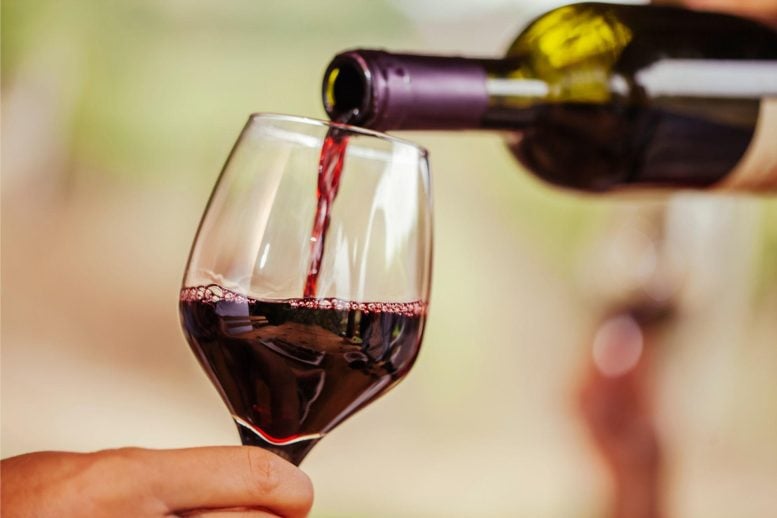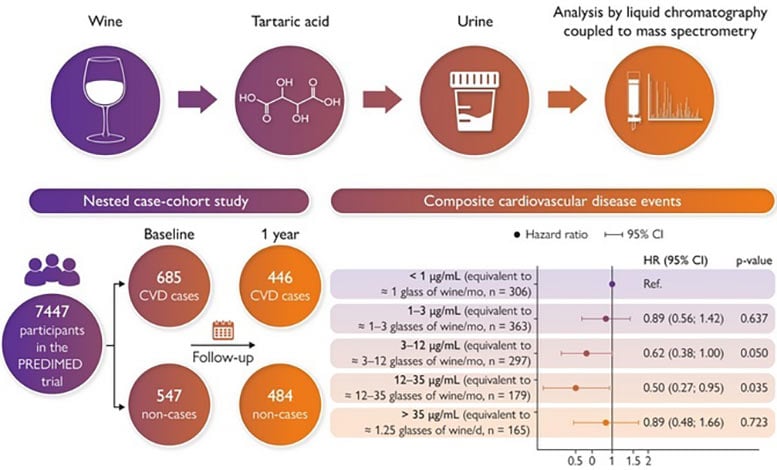博文
每天喝半到一杯葡萄酒可以降低50%的心脏并发症风险
 精选
精选
||
每天喝半到一杯葡萄酒可以降低50%的心脏并发症风险
诸平
据西班牙巴塞罗那大学(University of Barcelona)2024年12月31日提供的消息,每天喝半到一杯葡萄酒可以降低50%的心脏并发症风险(Drinking Half to One Glass of Wine Daily Linked to 50% Lower Heart Complication Risk)。
适度饮用葡萄酒可能会降低心血管风险高达50%,但需要更多的研究来证实这些结果并探索潜在的机制。
根据巴塞罗那大学医院(University of Barcelona, Hospital Clínic)、奥古斯特·皮·苏尼尔生物医学研究所{ August Pi i Sunyer Biomedical Research Institute(IDIBAPS)}、肥胖病理学和营养网络生物医学研究中心{ Physiopathology of Obesity and Nutrition Networking Biomedical Research Centre (CIBEROBN)}和纳瓦拉大学{ University of Navarra (UNAV)}的研究人员进行的一项全面的多中心研究,轻度至中度的葡萄酒消费与降低心血管并发症的风险有关。
该研究发表在《欧洲心脏杂志》(European Heart Journal)上,使用酒石酸(一种从葡萄中提取的生物标志物)来检测葡萄酒摄入量的影响。原文详见:Inés Domínguez-López, Rosa M Lamuela-Raventós, Cristina Razquin, Camila Arancibia-Riveros, Polina Galkina, Jordi Salas-Salvadó, Ángel M Alonso-Gómez, Montserrat Fitó, Miquel Fiol, José Lapetra, Enrique Gómez-Gracia, José V Sorlí, Miguel Ruiz-Canela, Olga Castañer, Liming Liang, Lluis Serra-Majem, Frank B Hu, Emilio Ros, Miguel Ángel Martínez-González, Ramon Estruch. Urinary tartaric acid as a biomarker of wine consumption and cardiovascular risk: the PREDIMED trial. European Heart Journal, 18 December 2024, ehae804. DOI: 10.1093/eurheartj/ehae804. https://doi.org/10.1093/eurheartj/ehae804
参与此项研究的有来自西班牙巴塞罗那大学{Universitat de Barcelona (UB), Barcelona, Spain}、西班牙马德里蒙福尔特·德莱莫斯的卡洛斯三世健康研究所(Instituto de Salud Carlos III, Monforte de Lemos 3-5, Pabellón 11, Madrid, Spain)、西班牙纳瓦拉大学(University of Navarra, IdiSNA, Irunlarrea 1, Pamplona, Spain)、西班牙罗维拉·维吉尔大学,圣琼大学医院(Sant Joan University Hospital, University Rovira i Virgili, Reus, Spain)、西班牙维多利亚加斯泰兹的巴斯克地区UPV/EHU大学阿拉巴大学医院(Araba University Hospital, University of the Basque Country UPV/EHU, Vitoria-Gasteiz, Spain)、西班牙巴塞罗那德尔马医院医学研究所{Hospital del Mar Medical Research Institute (IMIM), Barcelona, Spain}、西班牙马洛卡岛帕尔马市巴利阿里群岛大学和Son Espases医院的健康科学研究所(Institute of Health Sciences, University of the Balearic Islands and Hospital Son Espases, Palma de Mallorca, Spain)、西班牙塞维利亚初级卫生保健区(Sevilla Primary Health Care District, Sevilla, Spain)、西班牙马拉加大学(University of Malaga, Malaga, Spain)、西班牙瓦伦西亚大学(University of Valencia, Spain)、美国波士顿哈佛陈曾熙公共卫生学院(Harvard T.H. Chan School of Public Health, Boston, MA, USA)、西班牙大加那利岛拉斯帕尔马斯大学(University of Las Palmas de Gran Canaria, Las Palmas, Spain)、美国波士顿的哈佛医学院和布莱根妇女医院医学系(Department of Medicine, Harvard Medical School and Brigham and Women's Hospital, Boston, MA, USA)、西班牙巴塞罗那生物医学研究所{Institut d'Investigacions Biomèdiques August Pi i Sunyer (IDIBAPS), Barcelona, Spain}以及IDIBAPS和西班牙巴塞罗那大学的医院门诊部(Hospital Clinic, IDIBAPS, University of Barcelona, Rosselló 149-153, Barcelona, Spain)的研究人员。
这项研究涉及来自地中海饮食预防医学研究(PREDIMED)项目的1232名参与者,PREDIMED项目是一项大型流行病学研究,主要研究地中海饮食对心血管健康的影响。
据研究人员称,“毫无疑问,过度饮酒会对健康造成严重后果。然而,适度和负责任的葡萄酒消费的影响仍然是科学界争论的主题。这项研究和其他研究的结果应该有助于将适度饮酒作为地中海饮食的一部分,被认为是世界上最健康的饮食。”
该研究的主要作者是来自巴塞罗那大学(UB)制药与食品科学学院(UB’s Faculty of Pharmacy and Food Sciences)和营养与食品安全研究所(Nutrition and Food Safety Research Institute 简称INSA)的研究者伊内兹·多明戈斯(Inés Domínguez);来自巴塞罗那大学(UB)医学与健康科学学院(UB’s Faculty of Medicine and Health Sciences)和IDIBAPS的拉蒙·埃斯特鲁奇教授(Professor Ramon Estruch);来自纳瓦拉大学{ University of Navarra(UNAV)}的ICREA研究院教授、INSA成员罗莎·玛丽亚·拉穆埃拉(Rosa María Lamuela)和米格尔·安赫尔·马丁内斯教授(Professor Miguel Ángel Martínez)。
关于葡萄酒影响的争论(Controversy over the effects of wine)
当今,关于适度饮用酒精饮料对健康的影响,尤其是葡萄酒,存在很多争议。拉蒙·埃斯特鲁奇强调,“这场争论的部分原因是研究结果相互矛盾,一些研究指出葡萄酒有保护作用,而另一些研究则没有发现这种作用。”这些差异可以用葡萄酒消费记录中可能存在的错误来解释。
“评估葡萄酒在心血管事件发生率中的作用的流行病学研究通常基于葡萄酒消费的自我报告信息。”拉蒙·埃斯特鲁奇解释说,“这些都是可靠的数据,但由于不准确的回忆或对饮用酒精饮料的社会可取性的偏见看法,这些数据可能会出现测量误差。”
为了解决这个问题,研究人员在这项研究中通过食物摄入频率调查来测量葡萄酒的消费量,他们用一种客观的生物标志物来证实这一点:酒石酸的浓度,一种主要在葡萄中产生的分子,很少由其他植物合成。
从38%减少到50%(A reduction from 38% to 50%)
使用这种方法,该研究分析了PREDIMED患者队列中的葡萄酒消费量和心血管结果。总共有1232名参与者被评估,包括685名有心血管事件(心血管死亡、心肌梗死、中风或心力衰竭)和625名随机选择的参与者。
对数据的分析表明,少量饮用葡萄酒(每周一杯到每天不到半杯)可将患心血管并发症的风险降低38%,但当饮用适量葡萄酒(每天半杯到一杯)时,这一风险可降低50%。
然而,当每天饮用超过一杯时,保护作用就消失了。研究人员还警告说,“当我们谈论适度饮酒时,总是在用餐时,而不是在两餐之间。”
更多的研究来证实这一结果(More studies to confirm the results)
尽管有这些结论,伊内兹·多明戈斯指出,“这项研究的观察设计限制了建立因果关系的能力,”专家们指出,还需要进行更多的研究:“队列研究的结果应该得到更大的肯定。”
在这方面,他们指出了两个可能采取行动的途径。第一种方法将涉及随机营养干预研究的设计,通过将参与者随机分配到不同的葡萄酒消费组。
他们补充说,“进行这些研究是非常昂贵的。目前有一项研究正在进行中,但结果仍需要四到五年的时间。”第二项研究将是研究葡萄酒对心血管系统的保护作用机制,比如研究葡萄酒多酚类物质——如白藜芦醇(resveratrol)和其他酚类化合物(phenolic compounds)——的抗炎作用。他们总结说,“了解这些机制使流行病学队列研究的结果更加可信。”
本研究得到了PID2020-114022RB-I00/CICYT、卡洛斯三世研究所(Instituto de Salud Carlos III)、西班牙科学、创新与大学部(Ministerio de Ciencia, Innovación y Universidades)、美国国立卫生研究院(NIH)、地中海饮食、代谢物及心血管疾病项目(2R01HL118264-09 and 5R01HL118264-08/Mediterranean diet, Metabolites, and Cardiovascular Disease)、加泰罗尼亚政府(2017SGR 196/Generalitat de Catalunya)、欧洲研究理事会(101097681/European Research)、西班牙葡萄酒专业协会(600390/Interprofesional del vino de España-OIVE)、AEI、FEDER、MICIN以及UE的支持或资助。
上述介绍,仅供参考。欲了解更多信息,敬请注意浏览原文或者相关报道。
Background and aims: Moderate wine consumption has been associated with lower cardiovascular disease (CVD) risk in older populations. However, wine consumption information through self-reports is prone to measurement errors inherent to subjective assessments. The aim of this study was to evaluate the association between urinary tartaric acid, an objective biomarker of wine consumption, and the rate of a composite clinical CVD event.
Methods: A case-cohort nested study was designed within the PREDIMED trial with 1232 participants: 685 incident cases of CVD and a random subcohort of 625 participants (including 78 overlapping cases). Wine consumption was registered using validated food frequency questionnaires. Liquid chromatography-tandem mass spectrometry was used to measure urinary tartaric acid at baseline and after one year of intervention. Weighted Cox regression models were used to estimate hazard ratios (HRs) of CVD.
Results: Tartaric acid was correlated with self-reported wine consumption at baseline [r = 0.46 (95% CI 0.41; 0.50)]. Five categories of post hoc urinary tartaric acid excretion were used for better representation of risk patterns. Concentrations of 3-12 and 12-35 μg/mL, which reflect ∼3-12 and 12-35 glasses/month of wine, were associated with lower CVD risk [HR 0.62 (95% CI 0.38; 1.00), P = .050 and HR 0.50 (95% CI 0.27; 0.95), P = .035, respectively]. Less significant associations between self-reported wine consumption and CVD risk were observed.
Conclusions: Light-to-moderate wine consumption, measured through an objective biomarker (tartaric acid), was prospectively associated with lower CVD rate in a Mediterranean population at high cardiovascular risk.
https://blog.sciencenet.cn/blog-212210-1467103.html
上一篇:超市葡萄引发量子技术革命
下一篇:Hmga1:可修复受损心脏的鱼蛋白


